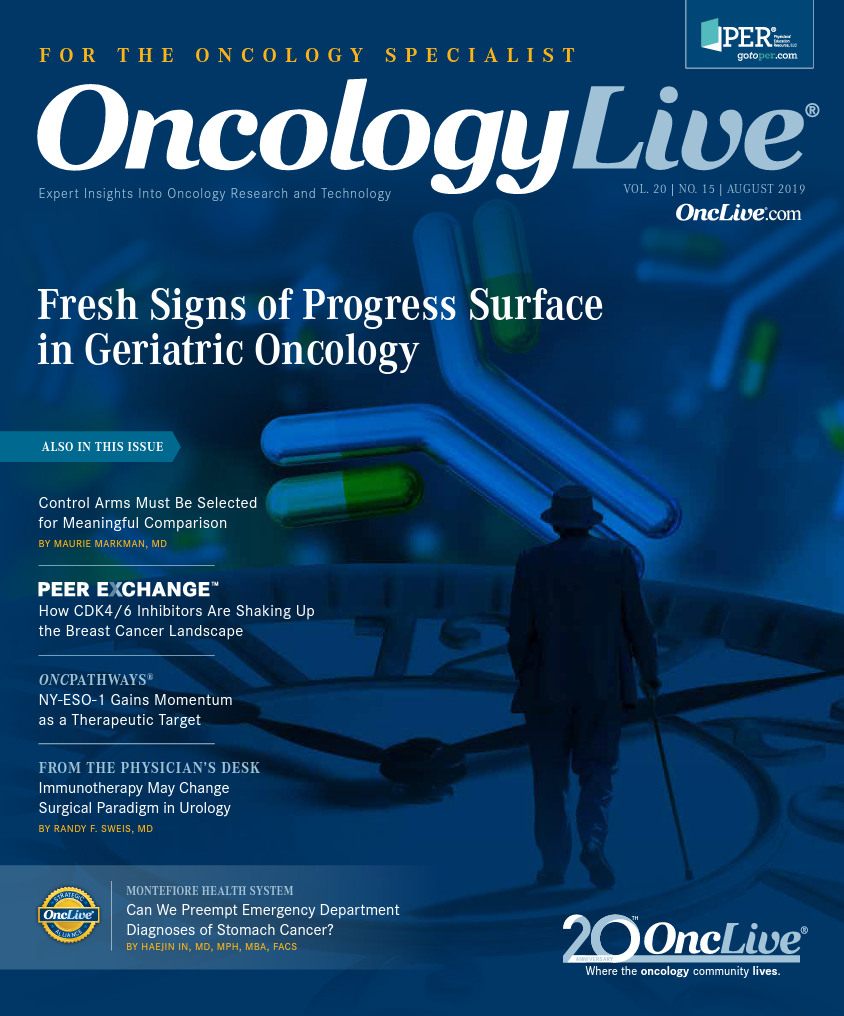Publication
Article
Oncology Live®
Can We Preempt Emergency Department Diagnoses of Stomach Cancer?
Author(s):
It is crucial to develop screening programs for stomach cancer in the United States in order to make diagnoses at earlier stages of disease, provide better care, and improve outcomes.

Haejin In, MD, MPH, MBA, FACS
Surgical Oncologist
Montefiore Health System
Assistant Professor of Surgery, Epidemiology, and Population Health Albert Einstein College of Medicine
The Bronx, New York
Stomach cancer is a deadly disease, with an overall 5-year survival rate of just 31%. It will strike an estimated 28,000 people in the United States this year.
A significant proportion of people receive a diagnosis of stomach cancer in the emergency department (ED), which is associated with worse outcomes because by then, the cancer is likely to have spread beyond the site of origin and is more challenging to treat. As with pancreatic cancer, many early symptoms, such as poor appetite, indigestion, and heartburn, might not seem life-threatening at first. It is only when the pain becomes severe that patients visit an ED.
At Montefiore Health System in The Bronx, New York, one of the busiest EDs in the nation, we conducted a retrospective study to improve understanding of stomach cancer diagnoses made in the ED.1
We looked at patients who received stomach cancer diagnoses between 2009 and 2013. Of 263 patients, 52% (n = 136) received a diagnosis following presentation at the ED, and among them, 50% had stage IV cancer. A survival analysis revealed that individuals who received their diagnosis in the ED had a median survival of 12 months versus 48 months for patients who received diagnoses outside the ED.1
Based on these findings, we believe it is crucial to develop screening programs for stomach cancer in the United States in order to make diagnoses at earlier stages of disease, provide better care, and improve outcomes.
In high-prevalence countries such as Korea, Mongolia, and Japan, population-wide screening for stomach cancer among middle-aged and older adults has reduced stomach cancer mortality by up to 60%.
Population-wide stomach cancer screening is not feasible in the United States because of low incidence in the general population. That said, stomach cancer has a disproportionately larger prevalence among ethnic minority groups and those with lower socioeconomic status (SES). Targeted screening of high-risk individuals could greatly reduce ethnic- and SES-related care disparities in this disease type.
In the United States, blacks, Hispanics, and Asians are 2 to 5 times more likely to receive a stomach cancer diagnosis compared with Caucasians2-5 (Figure5), and stomach cancer is a top-5 cancer for Koreans, Chinese, Japanese, Laotians, Vietnamese,6 and Native Hawaiians and other Pacific Islanders.7 Compared with non-Hispanic whites, South and Central Americans are 4 to 5 times more likely to receive a diagnosis of stomach cancer; Mexican Americans, 3 times; Puerto Ricans, 2 times.3,8 Having lower SES increases the risk of stomach cancer 1.25 to 4.33 times.9
To develop a model for earlier detection of stomach cancer, we conducted a pilot study titled “Development of a Gastric Cancer Brief Screener to Identify Persons for Screening Endoscopy Referral.” The study included 4 phases:
- A systematic review was performed to identify stomach cancer risk factors, and an exhaustive pool of risk factors from 16 existing survey instruments was developed.
- Focus group studies (N = 30 patients) were conducted for feedback on wording, layout, clarity, and relevance of the questions.
- The items were translated, and cognitive interviews (N = 60 patients) were conducted on the English, Spanish, Korean, and Mandarin Chinese versions to ensure the survey questions would be understood.
- The resulting pool of 227 risk factors was used to conduct a case-control study of 90 participants. The study showed that ethnic and immigration items were highly predictive. In particular, being foreign born and reporting daily consumption of cultural foods had 16 times (95% CI, 2.0-123.1) and 25 times (95% CI, 2.0-308.2) increased odds of cancer, respectively. Importantly, the study showed promise that a conservative survey model with as few as 5 items had potential to identify a cohort with a stomach cancer risk of 7 to 10 times higher than that of the general population.10
Figure. Racial and Ethnic Disparity in Gastric Cancer Risk5
This study showed that asking a simple set of questions could identify people who are at risk of stomach cancer and would benefit from screening. The results were published as the featured cover article of the July 2018 edition of the Journal of Surgical Research. With appropriate targeting, stomach cancer screening would be feasible and cost-effective in the United States. A tool to identify persons at high risk, by necessity, must be easy and inexpensive to use in both clinical and community settings so that it can draw high-risk individuals into the healthcare system for further testing. A short prescreening questionnaire has the potential to become a handy, noninvasive tool for identifying persons at high risk during a usual wellness visit in a hospital or community setting. Thereafter, the high-risk individuals can undergo a screening endoscopy.
These exciting results are being used as preliminary data for a National Institutes of Health grant proposal to conduct a large-scale, case-control study to develop a stable risk-prediction model for stomach cancer using demographics, diet, and lifestyle factors. The grant proposal will be submitted by the time you read this article.
References
- Solsky I, Rapkin B, Wong K, Friedmann P, Muscarella P, In H. Gastric cancer diagnosis after presentation to the ED: the independent association of presenting location and outcomes. Am J Surg. 2018;216(2):286-292. doi: 10.1016/j. amjsurg.2017.10.030.
- Siegel RL, Fedewa SA, Miller KD, et al. Cancer statistics for Hispanics/Latinos, 2015. CA Cancer J Clin. 2015;65(6):457-480. doi: 10.3322/caac.21314.
- Lui FH, Tuan B, Swenson SL, Wong RJ. Ethnic disparities in gastric cancer incidence and survival in the USA: an updated analysis of 1992-2009 SEER data. Dig Dis Sci. 2014;59(12):3027-3034. doi: 10.1007/s10620-014-3275-3.
- Haile RW, John EM, Levine AJ, et al. A review of cancer in U.S. Hispanic populations. Cancer Prev Res (Phila). 2012;5(2):150-163. doi: 10.1158/1940-6207. CAPR-11-0447.
- Noone AM, Howlader N, Krapcho M, et al. SEER cancer statistics review (CSR), 1975-2015, National Cancer Institute website. seer.cancer.gov/csr/1975_2015. Published April 2018. Accessed July 22, 2019.
- Gomez SL, Noone AM, Lichtensztajn DY, et al. Cancer incidence trends among Asian American populations in the United States, 1990-2008. J Natl Cancer Inst. 2013;105(15):1096-1110. doi: 10.1093/jnci/djt157.
- Liu L, Noone AM, Gomez SL, et al. Cancer incidence trends among native Hawaiians and other Pacific Islanders in the United States, 1990-2008. J Natl Cancer Inst. 2013;105(15):1086-1095. doi: 10.1093/jnci/djt156.
- Howe HL, Wu X, Ries LA, et al. Annual report to the nation on the status of cancer, 1975-2003, featuring cancer among U.S. Hispanic/Latino populations. Cancer. 2006;107(8):1711-1742. doi: 10.1002/cncr.22193.
- Uthman O, Jadidi E, Moradi T. Socioeconomic position and incidence of gastric cancer: a systematic review and meta-analysis. J Epidemiol Community Health. 2013;67(10):854-860. doi: 10.1136/jech-2012-201108.
- In H, Langdon-Embry M, Gordon L, et al. Can a gastric cancer risk survey identify high-risk patients for endoscopic screening? a pilot study. J Surg Res. 2018;227:246-256. doi: 10.1016/j.jss.2018.02.053.







%20u.jpg?fit=crop&auto=format)

%20(2)%201-Recovered-Recovered-Recovered-Recovered-Recovered-Recovered-Recovered-Recovered-Recovered-Recovered-Recovered-Recovered-Recovered-Recovered-Recovered-Recovered-Recovered-Recovered-Recovered.jpg?fit=crop&auto=format)
%20(2)%201-Recovered-Recovered-Recovered-Recovered-Recovered-Recovered-Recovered-Recovered-Recovered-Recovered-Recovered-Recovered-Recovered-Recovered-Recovered-Recovered-Recovered-Recovered-Recovered.jpg?fit=crop&auto=format)